If you’ve ever been enchanted by the sight of a baby capybara—that chubby, water-loving rodent with sweet eyes—you’re not alone. It definitely was the first time I watched a tiny capybara pup clumsily taking its first steps. These gentle giants of the rodent world are instantly adorable, and their baby stages are packed with surprising facts.
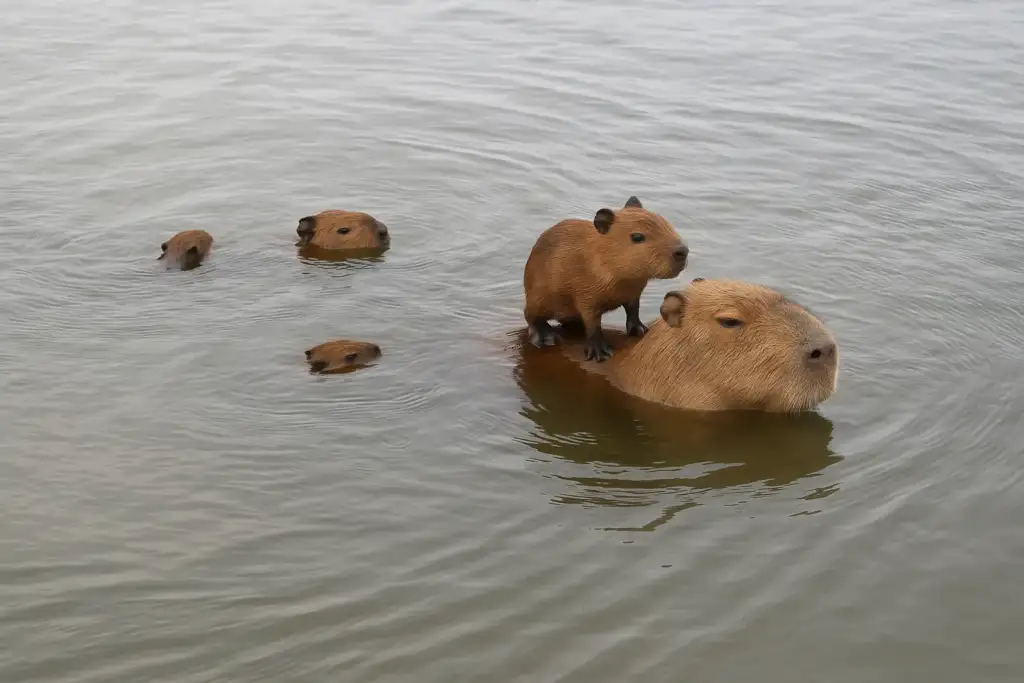
In this post, we’re diving deep into everything baby capybara:
→ what they look like
→ how they grow
→ fun internet videos
→ pet-care tips
→ and even their role in education.
Trust me, you’ll walk away smiling (and maybe humming an imaginary capybara purr of joy).
What Do Baby Capybaras Look Like?
Baby capybaras are born looking like tiny versions of their parents. Technically called pups, they arrive after about 5–6 months of pregnancy.
And get this—newborn pups are:
✔️ fully furred
✔️ eyes wide open
✔️ rocking a full set of teeth
They weigh just 2–3 pounds (1–1.5 kg) at birth—about the size of a small loaf of bread.
Yet even at that tiny size, they can:
→ stand up
→ take a few wobbly steps
→ and swim almost immediately
(Yep. A day-old capybara is already splashing around. Nature is wild.)
They’ve got soft brown fur, a gentle mini-guinea-pig face, and—because they’re semi-aquatic—eyes and nostrils placed high on their heads so they can see and breathe while floating.

You’ll often see baby capybaras huddled close to Mom while she rests. Look at their tiny whiskers and wide, alert eyes—this family bond starts early.
Capybaras live in communal families, and the herd helps raise every pup.
Any lactating female will nurse any baby—pups don’t just stick to their biological mom.
As one of my wildlife vets puts it:
“This ensures that all pups have access to the nutrients they need, regardless of the mother’s condition.”
A typical litter has around 3 pups, though some mamas have 5 to 8 babies at once (pbs.org). That’s when “village” parenting really kicks in.
And when you see a pile of pups snoozing together on Mom?
That’s the cooperative spirit in action, and a survival strategy that keeps these little guys safe in the wild.
Growing Up Fast: Capybara Development Stages
Capybaras grow like they’ve got somewhere to be.
Within just a week of birth, a capybara pup can start nibbling on grass, walking confidently, and keeping up with the herd. No awkward baby phase here—they hit the ground ready to go.
By 4 months, that tiny loaf of a pup might already weigh 25–30 pounds (12–14 kg) and be fully weaned. By 1 year, many are clocking in around 80–90 lbs (36–40 kg). And by 18 months, they’re nearing adult size—often topping 100+ lbs (45+ kg).
Honestly, watching a capybara grow feels like flipping through a nature time-lapse.
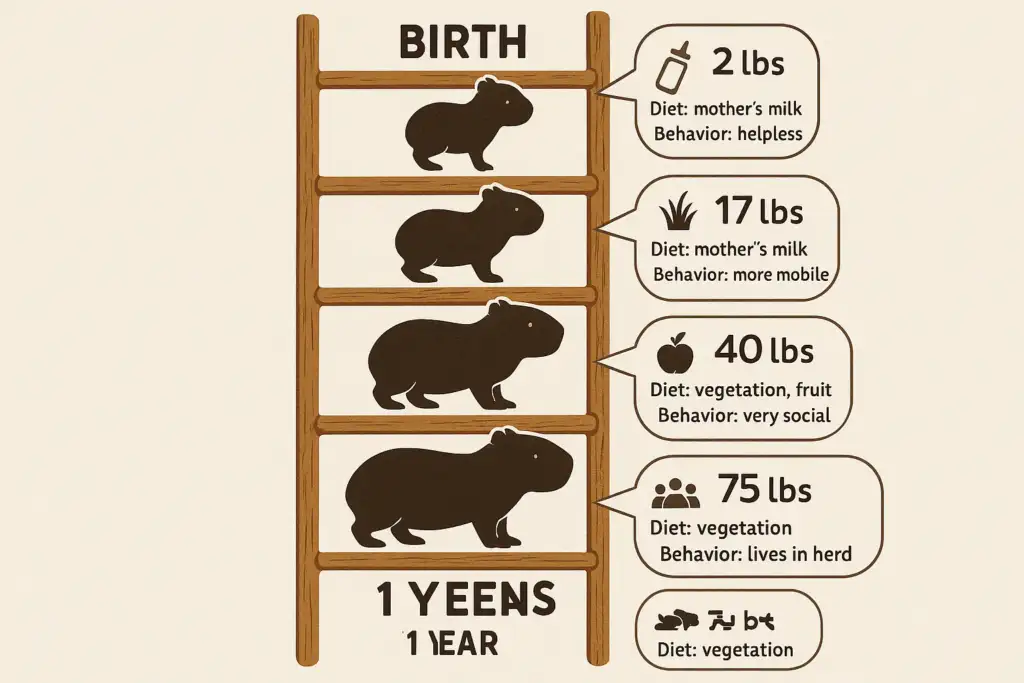
🐾 Capybara Growth Timeline
| Age | Approx. Weight | Diet | Development & Behavior |
| Birth | ~2–3 lbs (1–1.5 kg) | Nursing (milk from any female) | Born with fur, open eyes, and teeth. Can already walk a little and swim within hours. |
| 1 week | ~2–3 lbs | Milk + beginning grass | Joins the group, walking and grazing within days. Still nurses, but has started trying solid food. |
| 4 months | ~25–30 lbs (12–14 kg) | Mostly grass (weaned) | Fully weaned off milk. Learning to forage, getting very social with siblings and herd members. |
| 1 year | ~80–90 lbs (36–40 kg) | Grass, veggies, fruits | Nearly full-grown. May start exploring more, but usually stick close to the family herd. |
| 18 months | ~100–140 lbs (45–63 kg) | Adult herbivore diet | Reaches sexual maturity and full adult size. Becomes part of the herd’s social structure. |
By just a few weeks old, pups are ready to explore. You’ll often spot them in marshy areas, alert and curious, grazing, playing, or following the grown-ups around like fuzzy ducklings.
📸 Picture this: three juvenile capybaras trekking through tall grass, sniffing everything in sight. They’ve gone from tiny newborns to mini tanks in just a few months.
A Few More Key Numbers
🦷 Teeth & Weaning
Pups are born with teeth, and they waste no time putting them to use. They usually start on solid plants immediately and are fully weaned by 16 weeks (around 4 months).
💌 Sexual Maturity
Females typically reach puberty at 7–12 years. Males take a little longer, 15 to 18 months on average.
⏳ Lifespan
In solid care (whether in captivity or the wild), capybaras can live around 6–12 years. That means a pup born today could still be lounging in your backyard or zoo enclosure in 2035.
Human Connections: Stories & Firsthand Encounters
I still remember the first time I met a baby capybara—at a small wildlife rescue near my hometown. I was clutching my camera, trying not to spook anything, and as I knelt beside the pool, a curious little pup paddled right up to me. Nose twitching. No hesitation. It gave me a gentle nudge—like, “Hey, you look new here.” Then it turned around and waddled back to its mom.
That quiet moment of trust from a wild animal? It stuck with me.
And I’m not the only one with stories like that:
- Sara’s Sanctuary Visit: “Watching three pups huddle on their mother’s back was the sweetest thing. One of them even fell asleep mid-swim, bobbing gently like a fluff ball on water.”
- Jake’s Zoo Memory: “When I was a kid, I fed a baby capybara its first pumpkin slice. It came right out of my hand—no fear. I’ve never felt a connection that pure with any other animal.”
Family and Social Life
Capybaras are incredibly social. Unlike many animals, where babies are hidden away in nests, capybara pups are out in the open with the herd from the get-go.
A typical group has about 10 members, led by a dominant male, plus several females and their kids. But during the dry season, or in vast open wetlands, those numbers can grow into the dozens or even hit triple digits. Picture a floating neighborhood barbecue—if everyone at the barbecue were a giant aquatic guinea pig.
And for baby capybaras? That crowd is survival.
Adults keep watch like sentries. If a predator appears, the herd closes ranks, and the pups dive into the water. An adult capybara can stay underwater for up to five minutes to avoid danger, and the babies? They instinctively follow, swimming like pros from day one.
They also learn fast. Social rules. Who’s in charge? Where the tastiest grass is. When it’s time to wallow, and when it’s time to chill in the sun.
People often describe capybaras as “nature’s therapy animals.” There’s a reason for that. Their vibe is calm, grounded, and… honest, comforting. One teacher once described them as “surprisingly dog-like—social and playful, always ready for a dip or a nap.” (Same. I relate.)
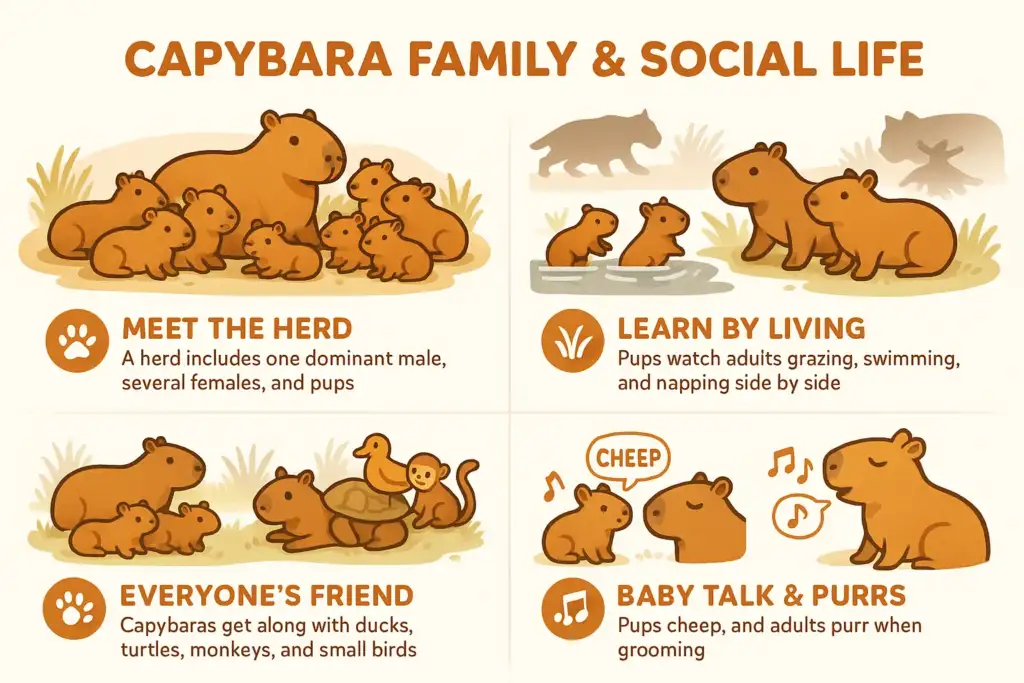
A Few Fun Social Quirks:
- Almost Nothing Phases Them
Capybaras famously get along with almost any other animal. There are endless photos of pups snuggling up to ducklings, puppies, turtles, monkeys—you name it. In the wild, they’ve even been seen relaxing with birds on their back or chilling next to caimans. - Their Baby Talk Is Adorable
Capybara pups communicate with soft cheeps and whines to get mom’s attention. And when they’re really content? They purr. Yep, giant rodents that purr when they’re happy. Usually when being petted, groomed, or after a good mud bath.
Fun Facts About Baby Capybaras 🐾
🍼 Born Ready
Baby capybaras don’t waste any time. They’re born with teeth, eyes wide open, and the instincts to walk and swim. Some caretakers have even seen pups hopping into the water on their very first day. Nature didn’t come into play.
👩👧 Communal Babies
One of the most wholesome things about capybaras? Pups can nurse any lactating female in the group. So even if a baby’s mom isn’t around, the rest of the aunties step in. Nobody goes hungry in the capybara village.
⚡ Speedy Growth
In their first year, baby capybaras can go from 3 pounds to nearly 90. That’s the rodent version of a human baby reaching adult size in under 12 months. Basically, blink and you’re looking at a full-grown floof.
🌱 Herbivore Heavyweights
These grass machines graze constantly—80% of their diet comes from just a handful of grass species. Even as babies, they’re munching on aquatic plants, grasses, and the occasional fruit. As adults? They down 6–8 pounds of greens a day. That’s commitment.
📲 Social Media Stars
Let’s be honest—baby capybaras are peak internet content. On TikTok alone, #capybara has racked up over 116 million views. You’ve probably seen videos like “Baby Tupi tries pumpkin for the first time” or clips of pups chilling in bathtubs. They’re the definition of serotonin.
🐀 Biggest Rodent on Earth
Capybaras are the largest rodents in the world, and even as babies, you can tell they’re built differently. They’ve got a four-chambered digestive system to process all that rough plant matter, and funky four-toed feet made for swamp trekking.
🕰️ Long Lifespan
When cared for properly (and legally), baby capybaras can live 6 to 12 years. So if you’re adopting one, know that you’re signing up for a decade of snuggles, snacks, and squeaky little purrs.
🌎 Conservation Note
Capybaras are currently listed as “Least Concern,” which is great. But habitat loss and hunting still affect some local populations. Sharing adorable baby capybara content helps people connect with these animals, and that awareness can translate into action.
Baby Capybaras in Pop Culture & Media
It’s no surprise these pups are internet sensations. Zoos and wildlife centers know people love them, so they often feature babies in videos.
🎥 Viral Fame on TikTok and YouTube
For example, San Antonio Zoo’s little capybara Tupi has her own TikTok fan club – clips of her munching and splashing went mega-viral. On YouTube, you can find countless compilations like:
- “Baby Capybara Playing – CUTEST Moments!”
- “Baby Capybara Tries Snacks”
Even mainstream news outlets jump in sometimes—ABC News posted a popular segment of a baby capybara meeting a duckling.
A 2024 article called Capybaras: the darlings of social media :
“TikTok and Instagram are the capybaras’ red carpets. Videos of them lounging in bathtubs, swimming gracefully, or balancing oranges on their heads have gone viral.”
And yes, #capybara has 116 million views on TikTok. That’s not just viral… that’s internet royalty.
😂 Memes and Internet Culture
Many memes have sprung up, too. You’ll spot still images of capybaras with captions like:
- “When life gets tough, be like a capybara: just chill.”
- Or a capybara with ducks on its back captioned: “Squad goals.”
And if you browse Reddit’s r/aww or r/Capybara, fans often comment things like:
- “Nature’s therapist”
- “Liquid Zen”
They’ve become the calm mascot we didn’t know we needed.
🧸 Capybaras in Games, Movies, and Fan Art
Beyond videos, capybaras (babies included) have even popped up in fiction and games lately.
- Remember the capybara in the movie Encanto?
Kids who love the film often end up idolizing capybaras afterward. - On social media, there’s a whole wave of capybara fan art—
Think: “capybara with a scarf” or “capybara drinking tea” stickers. Apparently, cozy capys are a thing now. And we love it.
In Short: They’re Everywhere—And We’re Here for It
Baby capybaras have captured hearts across the globe. Their gentle antics offer a mini-escape from the chaos of everyday life. And honestly? It’s hard not to smile when you see one.
(Full disclosure: I have a playlist of Capybara ASMR videos for when I need to relax – nothing beats the sound of one munching on fresh grass.)
Can You Own a Baby Capybara?
Cost, Care, and Legalities
All this talk of adorableness naturally leads to the question:
“Can I get one as a pet?”
The honest answer is maybe, but be very, very careful. Capybaras can make pets under specific conditions, but they are not beginner or casual pets.
Let’s walk through the essentials:
1. Legality
First off, check your local laws. In the USA, some states like Texas, Florida, Arkansas, and Indiana allow capybaras (usually with minimal red tape). Others ban them outright or require exotic animal permits.
Pro Tip: One real estate blog actually had a handy list of “states that allow capybara ownership” – including Texas, Florida, Mississippi, Pennsylvania, and several more.
If your city or state doesn’t permit them, that’s a hard stop.
2. Cost
A baby capybara typically costs $1,000–$3,000 from a breeder.
(Yes, like a purebred dog.)
Then factor in 100% of costs for habitat, food, and vet care.
3. Space & Environment
Capybaras are big. Adults need a lot of room. Experts recommend at least 400 square feet of secure outdoor space per capybara.
- You’ll need a sturdy fence (they aren’t climbers but will push, burrow, and chew through weak barriers).
- Non-negotiable: a large wading pool or pond. These creatures live for water – literally. Swimming and soaking are daily essentials for hygiene and joy.
(Owners commonly fill kiddie pools or build backyard ponds.)
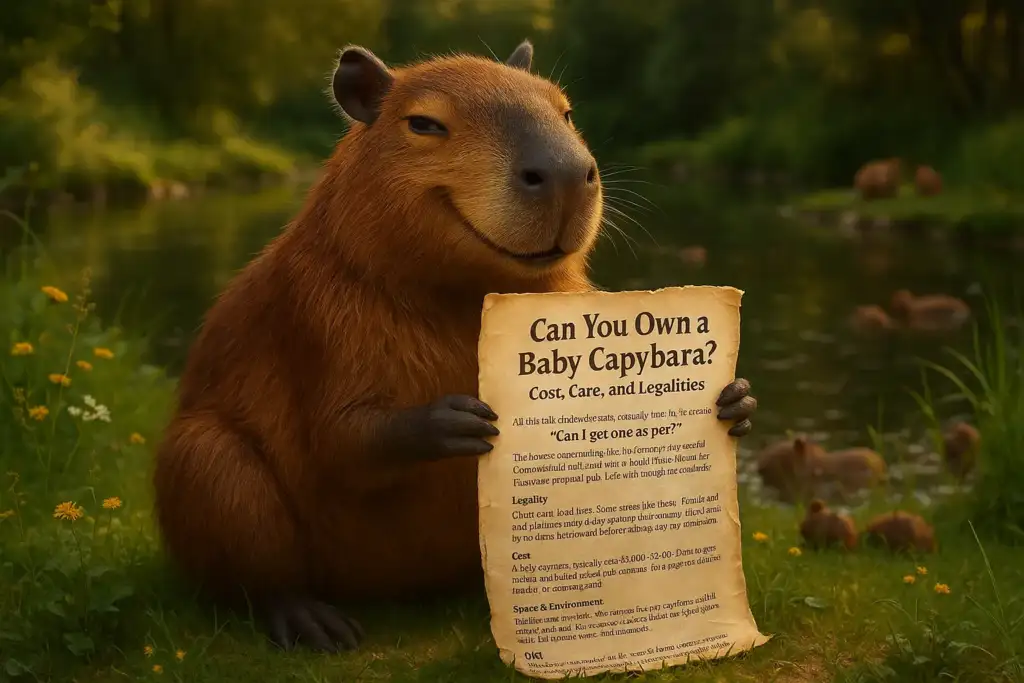
4. Diet
Capybaras are grazing machines.
They need constant access to grass, hay, and vegetables.
- They nibble fruits occasionally.
- Avoid starch-heavy or sugary treats.
- If food bowls are empty, they’ll go for anything: your plants, furniture, electrical cords–it’s all fair game to a hungry capybara.
5. Social Needs
Never keep just one.
Capybaras must have a buddy–they form deep bonds with their own kind.
Owners and breeders universally stress pairing them up. One guide bluntly puts it:
“If you love capybaras, have at least two so they can bond with each other rather than just you.”
Also, be prepared to spend daily quality time with them – capybaras are smart and emotional.
6. Vet Care
You’ll need access to an exotic animal vet.
Capybaras have unique needs:
- Teeth that grow continuously
- Skin that’s prone to infection in dirty water
- Specific vaccines (like rabies or leptospirosis, depending on the region)
One care guide noted:
“Not all veterinarians are trained to handle exotic animals like capybaras… capybaras can be prone to dental problems and skin infections, so it is important to provide appropriate care when needed.”
7. Behavior & Training
Baby capybaras can bond with humans if raised gently, but they’re still wild animals at heart.
- They don’t potty-train
- They’ll chew furniture, wires, shoes – even metal or plastic if bored.
- And they’re known to soil your house if allowed indoors unsupervised.
In short: dog-like? Maybe. House-ready? Not really.
8. Commitment
From the moment you get a baby (ideally two), this is a multi-year commitment. Capybaras live 6–12 years in good care.
Early days take extra work:
- Babies should ideally stay with their mom for 7–14 days after birth
- They might require hand-feeding, puppy chow, heating pads, and round-the-clock monitoring.
It’s basically a furry toddler… who swims.
In Summary
Keeping a baby capybara is expensive, complex, and not for the faint of heart.
But for those fully prepared, the reward can be a deeply affectionate, quirky companion. Owners who get it right often describe them as gentle, dog-like, and full of personality.
That said, if you’re just curious, consider visiting a capybara sanctuary or rescue farm. It’s a great way to enjoy their magic without taking on the full-time responsibility.
✅ Never buy from illegal breeders or unlicensed sellers
✅ Always check laws and housing needs
✅ Always put the capybara’s well-being first
Capybaras in Education and Conservation
Capybaras aren’t just cute—they’re teachable moments on four legs.
Biology & Adaptation Lessons
Capybaras are ideal for explaining semi-aquatic adaptation:
- Their “face-on flotation design”—eyes, ears, and nose placed high—lets them breathe while submerged
- Their fur dries fast, and they roll in mud to prevent sunburn and parasites.
They also make for great mammal social structure comparisons—think wolves or primates, but fluffier.
Even their digestive system (a multi-chambered stomach) is gold for lessons on herbivore digestion.
Taxonomy & Evolution
Capybaras used to confuse early explorers.
They were dubbed “water hogs” and mistaken for pigs until scientists realized their teeth, gut, and biology were pure rodents.
They’re now known as the giant cousins of guinea pigs and chinchillas.
Fun fact:
They were literally classified as pigs at one point–until rodent science caught up.
Conservation Impact
Capybaras are not endangered (IUCN: Least Concern)–but they’re key players in their ecosystem.
- They’re important prey for jaguars, anacondas, and caimans.
- Their grazing helps shape wetland vegetation.
Spotting a capybara family in the wild is a fantastic field trip opportunity, especially with babies in tow.
Educators even use capybara stickers, coloring sheets, and posters in classrooms because… well, kids love them.
Home Learning & Edutainment
Want to teach your kids about nature?
- Twinkl has capybara-themed educational resources.
- PBS Nature clips on their mating and group life spark curiosity about biology
- And yes, capybara cartoons are a thing. (Capybara with a scarf? Adorable.)
In a Nutshell
Baby capybaras are a perfect mix of adorable and educational.
From their loaf-like birthweight to their social growth in the herd, they teach us so much about nature. They’re internet darlings, yes—but they’re also a living lesson in wetland life, cooperation, and adaptation.
Whether you’re watching one waddle into a pond or cuddle with a duckling, you’re witnessing something magical.
So enjoy them. Learn from them. And if you’re ever tempted to bring one home, do your homework first.
References:
For reference, visit the following trusted Sites:
Thanks for Reading!
If you’ve made it this far, you’re officially part of the Capybara Family Fan Club 🦫💧
Got a favorite video or question? Drop it in the comments—I’d love to hear from you.
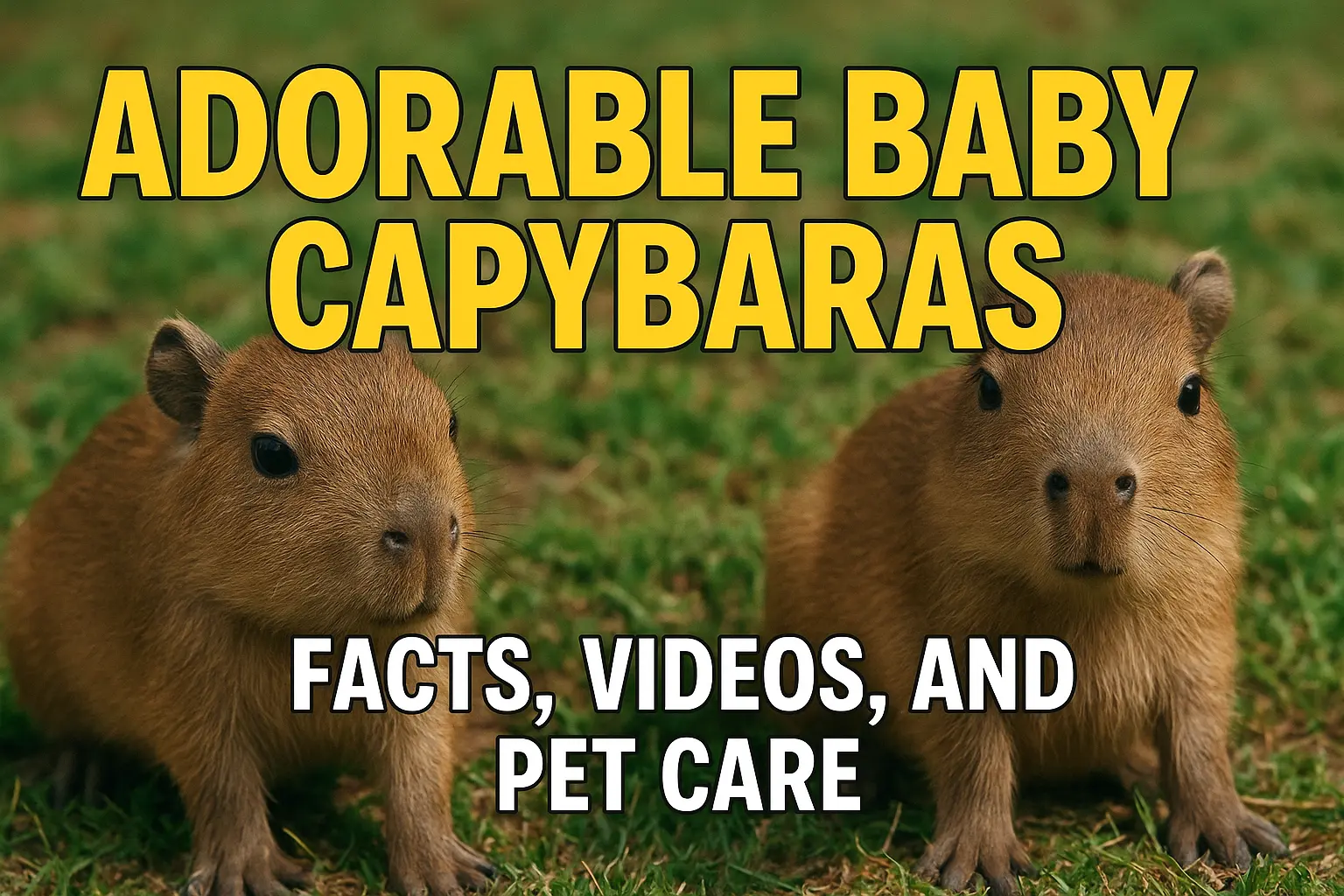
Leave a Reply